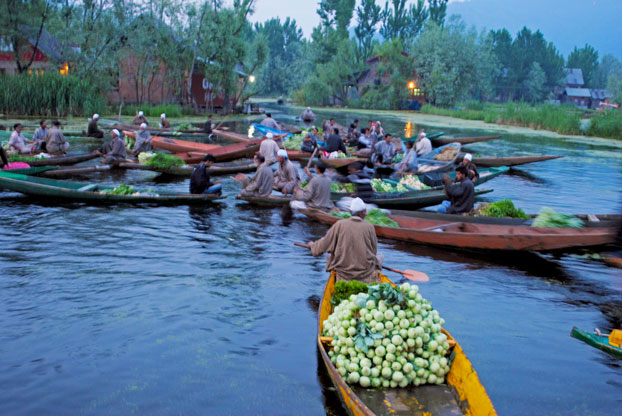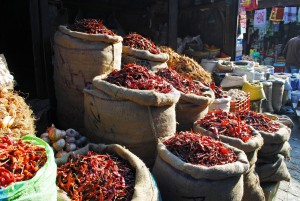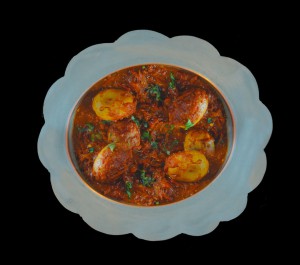Little known facts of Kashmiri food

It was my very first meal at the family homestead in Srinagar. We were all seated on the thickly carpeted floor, with copper bowls in front of us covered entirely with a fine layer of tin. The soft, warm glow of copper was lost, alas, but the gleam of tin in the family kitchen made a fine sight. Each of our bowls — those for men and women were differently shaped — had been filled with rice and all we had to do was to help ourselves from the row of small serving bowls in front of us. It was almost like a deconstructed thali. The starch was pre-portioned and the accoutrements were pre-organised, to provide various proteins and vegetables, not to mention colours and textures.
But what happened next took me by surprise. Abba bent his head, picked up a scoop of dry rice and popped it into his mouth. Hafeez, my husband,whispered: “Start eating,” but this was the first time I had seen rice being eaten on its own, with not a drop of any accompaniment! That, I soon learnt, is what Kashmiris mean when they call rice a staple: they can, to a man, eat a few mouthfuls of it without any gravy at all. In Delhi and elsewhere, we consider rice as a sort of background to the main part of the meal — the accompaniments. In Kashmir, it is the very reverse. Every time, over the last quarter of a century that I have been married, that we buy a new consignment of rice, the first time it is cooked, all we do is dissect the nuances of taste and texture minutely. I use the word ‘we’ loosely, of course. I am no closer to prising out the secrets of Kashmiri — or any other kind — of rice.
On the other hand, the vegetables that we buy are of great interest to me, as are the spices that are grown in the Valley. Firstly, the vegetables that are grown in Kashmir have a total solid content compared to their counterparts in the plains. Take just one example: cauliflower. You can cut it into large florets, deep fry it with a pinch of turmeric (to imbue it with a golden tinge: white-coloured foods do not find much favour in the Valley), pop them into gravy made with tomatoes and pressure cook the whole lot a couple of times, and they will still hold their shape! It is the identical process with Kashmiri potatoes, Kashmiri turnips etc.
Not surprisingly, vegetables grown in the Valley are far more expensive than those that come in, usually bedraggled, from the plains, after an arduous journey by road to the wholesale market in Parimpora, on the outskirts of Srinagar.
The pressure on real estate, thanks to increasing population, means that the vegetable patches that existed on swathes of land in the Old City, have now all been built upon, so there is greater dependence on vegetables from the plains. On the plus side, there are still the Dal vegetables, surely a unique concept. A ‘bed’ is made with an ingenious mix of reeds, branches, dried weeds and a bit of silt. It floats on the surface of the lake and is used to grow every conceivable vegetable, from tomatoes to red cockscomb — not technically a vegetable, but indispensable in Kashmiri cuisine for the deep carmine colour it imparts to roghan josh and mirchwangan korma, without influencing the flavour. All the vegetables grown on the Dal are sold at dawn in a magically romantic market right on the lake from boats. As a spectacle, few sights match up. And you can grow vegetables for your immediate family or for selling in the pre-dawn market.
I have seen the market on the Dal several times over in the last 25 years, as also markets, small and large, across Srinagar and other parts of Kashmir. The concept of ‘exotic’ vegetables like baby corn and broccoli are unheard of, so it is striated beans in early autumn, garlic in spring, tomatoes and aubergines towards late autumn, along with the humble bottle gourd. In Kashmir, autumn is the one season where nature shows off her bounty. Turnips, their tops an almost unnatural purple, are the favourite vegetable. All through summer, kohlrabi and haakh (collard greens). Green peas, carrots and cucumbers, sweet and fresh as they are, hardly have the same cachet, somehow.


Rice – Kashmiri style
The word for meal — batthe — is the same as that for rice. Not only that: there is a separate word for paddy, (shali); after it is husked (tomul), just before it is put into the cooking pot (vye) and after it is cooked (batthe).
Kashmiri rice grows from a seed that in agricultural parlance is called K-448 (not very romantic, I know, but that’s how it is). The grain is not as long or as fragrant as basmati is, but is short and quite dense. I have known Kashmiris living outside the State to make do with varieties of rice from South East Asia rather than ‘descend’ to the level of the far drier basmati.
Kashmiris usually eat while seated on the floor; the plates being arranged on a dastarkhan or long cloth. When any other variety of rice drops on the cotton cloth, it is dusted off easily enough; when Koshur tomul (Kashmiri rice) falls, it has to be scraped off meticulously. This is because of the sheer amount of starch in the grain: far more than the starch content of the varieties grown in the plains. It is for this reason diabetics in Kashmir are expressly forbidden to consume rice.
Needless to say, Kashmiri rice is grown only in the Kashmir Valley, the best coming from District Pulwama that used to be known as the rice bowl of Kashmir. There isn’t enough rice grown in Kashmir to go around for every family to subsist entirely on Kashmiri rice, so it has to be used in tandem with rice brought in from the plains, whose variety is close enough to the Chinese variety and is called C-103, in which C stands for China!
No other variety of rice would be consumed at a wazwan besides Koshur tomul, considered by Kashmiris as so delicious as to be eaten on its own, without any accompaniment!
Its stickiness is sought to be minimised by the cooking method adopted — it is boiled in large quantities of water, which is drained when the rice is cooked. It is then ‘dried’ completely by placing on a just-warm fire with a thick cast-iron plate under the vessel so that the starch dries up to the optimum extent
However, every Kashmiri’s favourite vegetables are the ones that can be dried in the warm autumnal sun and preserved for the harsh winter. There used to be a time when dried vegetables were the only option in winter, when snow lay thick on the ground and the road from Jammu — and thence to the plains — was closed to vehicular traffic. Global warming has meant consistently less snow every winter and progress has meant that snow on the national highway is cleared within a few hours, so the need for dried vegetables is largely redundant.
However, it is huge on the nostalgia factor, so when the skies are heavy and grey, every family in the Valley makes plans to cook moong dal with boiled eggs or thick slices of turnips in a sauce made with sun-dried tomatoes. And when our family settles down to sun-dried aubergines cooked with sun-dried onion slices, we don’t bother to nibble plain rice first: we just dive right in.
Pictures by Marryam Reshii
